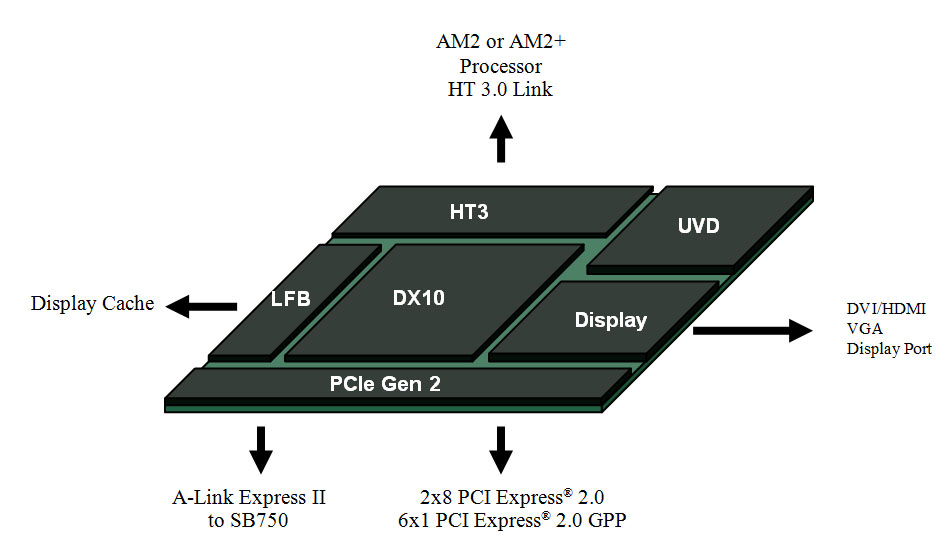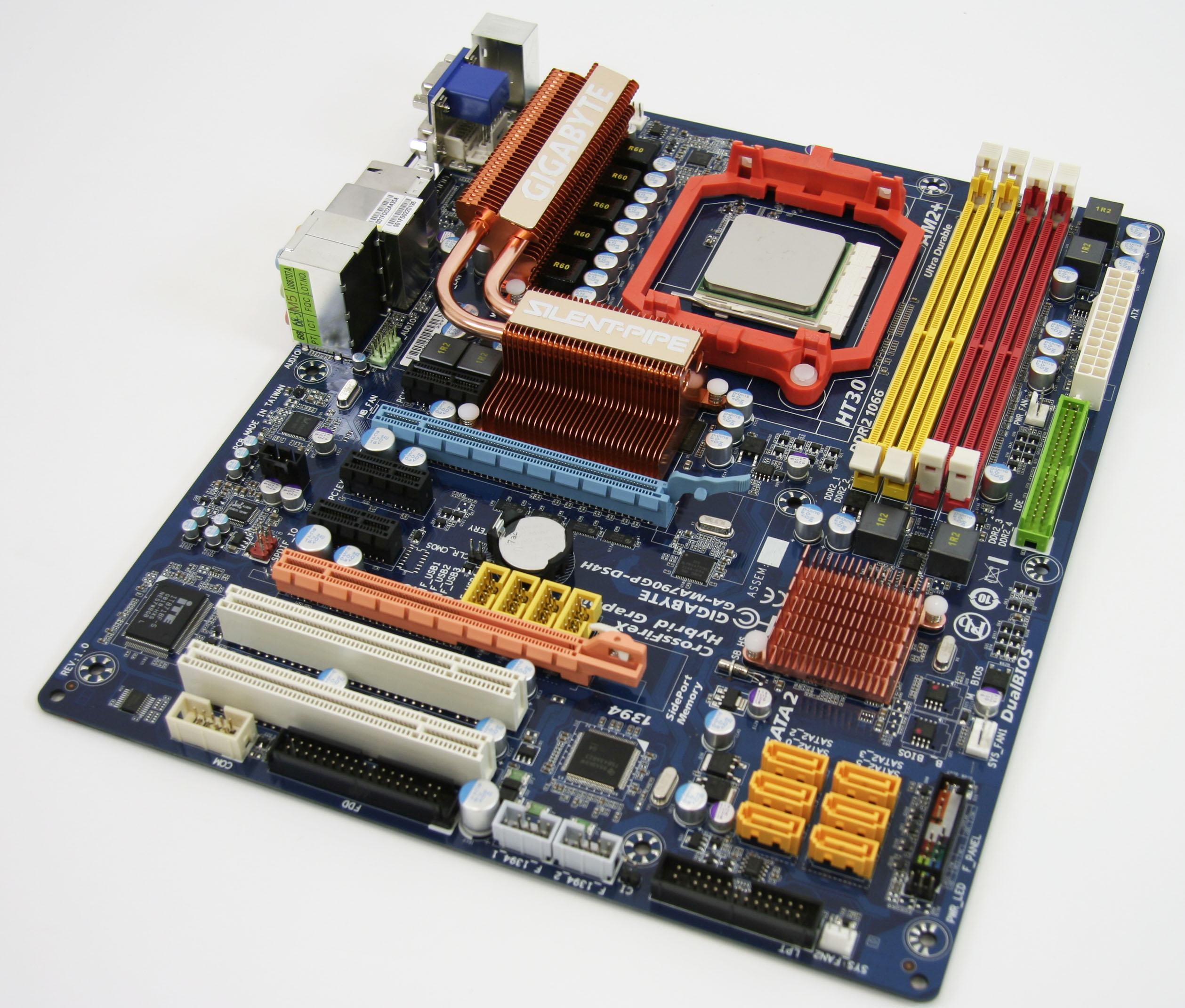AMD 790GX: RV610 For Enthusiasts?
790GX: Dissected
The 790GX consists of two components (versus Nvidia’s single-chip platforms) : the 790GX northbridge and an SB750 southbridge.
790GX : A Little of This, A Little of That
From the top-down, chipset diagram view, there’s actually very little distinguishing the 790GX northbridge from the 780G that came before it. Both components support HyperTransport 3 connectivity to AMD’s latest processors (790GX runs at up to 2.6 GHz). They both incorporate dual, independent display controllers — one digital and one analog. Support for DVI, HDMI, and DisplayPort are shared between the pair. And the two include onboard graphics based on AMD’s RV610 core.
However, one noticeable difference is PCI Express connectivity. Both chipsets boast a x16 PCIe 2.0 link for graphics. But while the 780G takes a single add-in card, 790GX is able to branch off into a pair of x8 links, offering the same 8 GB/s per slot you’d get from a first-gen x16 connection.
The flexible PCIe configuration lets 790GX boast CrossFireX support for higher-end gaming, similar to what Nvidia did with 780a SLI, which begs the questions, “How many enthusiasts need integrated graphics on their gaming machine” and “How many mainstream gamers need a pair of x16 slots for dual-card setups ?” Aren’t the 790FX and 780G chipsets already doing a great job keeping those respective segments satisfied ?
Fortunately, 790GX offers more than just a divisible PCIe link. The integrated RV610 core, armed with 40 stream processors, the same UVD support, and a 16-bit memory interface gets accelerated from 500 MHz on 780G to 700 MHz on 790GX — exciting since the northbridge is manufactured using the same 55 nm process used to etch 780G. Then again, AMD always did seem confident in the core’s available headroom. As a result of its higher clock, the graphics solution is now being called Radeon HD 3300-class.
Moreover, the side-port memory feature made available to board vendors before (but was rarely used) looks like it’s turning into a standard feature. As a refresher, side-port memory is a DDR2/DDR3 cache that lives on the motherboard, directly connected to the graphics core. Without the memory, the RV610 core utilizes the HyperTransport interface to access DDR2 memory attached to the processor’s integrated controller. But by adding even just 128 MB of DDR3 running at 1,333 MHz, AMD claims performance jumps by as much as 15 percent. We’ll be putting those claims to the test in a performance suite brand new to Tom’s Hardware.
Get Tom's Hardware's best news and in-depth reviews, straight to your inbox.
| AMD 790GX | AMD 780G | Nvidia GeForce 8300 | |
| Processor Interface | HT 3.0/5,200 MT/s | HT 3.0/5,200 MT/s | HT 3.0/5,200 MT/s |
| PCI Express Support | 2.0/26 lanes/2x8 Graphics | 2.0/26 lanes/1x16 Graphics | 2.0/19 lanes/1x16 Graphics |
| Integrated Core | RV610 | RV610 | G86 |
| DirectX/OpenGL | 10.0/2.0 | 10.0/2.0 | 10.0/2.0 |
| Graphics Clock | 700 MHz | 500 MHz | 500 MHz |
| Display Outputs | DisplayPort, HDMI, DVI, VGA | DisplayPort, HDMI, DVI, VGA | HDMI, DVI, VGA |
| Multi-GPU | Hybrid CrossFireX, CrossFireX | Hybrid CrossFireX | GeForce Boost |
| Addtl. PCIe | Six x1 PCIe 2.0 | Six x1 PCIe 2.0 | Three x1 PCIe 2.0 |
| Southbridge | SB750 | SB700 | N/A |
| Interconnect | A-Link Xpress (4 x PCIe 1.1) | A-Link Xpress (4 x PCIe 1.1) | N/A |
| RAID Support | RAID 0, 1, 10, 5 | RAID 0, 1, 10 | RAID 0, 1, 10, 5 |
| Audio | HD Audio | HD Audio | HD Audio |
| USB | 12 USB 2.0 + 2 USB 1.1 | 12 USB 2.0 + 2 USB 1.1 | 12 USB 2.0 |
| Ethernet | N/A | N/A | Gigabit Ethernet |
Beyond the core’s 3D capabilities, 790GX retains the same video capabilities introduced with 780G. Mainly, it boasts the first-gen Avivo HD display pipeline, including AMD’s Universal Video Decoder. Even if you don’t install a discrete card, the integrated core’s UVD handles Blu-ray playback with ease. To that end, HDCP support is of course an important part of the package and, like AMD’s add-in boards, the Radeon HD 3300’s HDMI output does S/PDIF audio as well. It simply lacks some of the functionality introduced with the RV770 core : acceleration of dual video streams, dynamic contrast, and 7.1-channel audio over HDMI.
As with 780G, 790GX offers two independent display controllers ; one analog (VGA) and the other digital (dual-link DVI, HDMI, or DisplayPort). In all frankness, we would have liked to see two digital outputs this time around. After all, if a gamer is flush enough to afford two cards in CrossFire, he probably has a couple of LCDs, too. Given the scarcity of DisplayPort-equipped displays, expect most 790GX boards to include VGA, DVI, and HDMI outputs, just like we saw with 780G.
Current page: 790GX: Dissected
Prev Page Integrated Graphics Go High-End Next Page AMD’s Peace Offering: SB750-
kitsilencer Great review, and it's good to see that AMD is at last able to target more enthusiast markets competitively.Reply -
cangelini kitsilencerGreat review, and it's good to see that AMD is at last able to target more enthusiast markets competitively.Reply
Thanks for the feedback Kit. -
waffle911 So... why does a page 15 and 16 of this article exist if there is no page 15 or 16 to the article?Reply
Take a closer look. What happened? -
YYD PCMark seems Intel biased, please read this:Reply
http://arstechnica.com/reviews/hardware/atom-nano-review.ars/6
Please change this benchmark suite or check if PcMark Vantage is unbiased. -
cangelini waffle911So... why does a page 15 and 16 of this article exist if there is no page 15 or 16 to the article?Take a closer look. What happened?Reply
That was strange. Should be fixed now.
-
cangelini YYDPCMark seems Intel biased, please read this:http://arstechnica.com/reviews/har view.ars/6Please change this benchmark suite or check if PcMark Vantage is unbiased.Reply
Fortunately, with no Intel platforms tested, this should be a non-issue for the current situation ;-) In the future, you'll be seeing SYSmark, though. -
Seems past page 8 or something the links are corrupt.. can't fully read this article and getting error 404 - page not found.Reply
-
cangelini lacrits.. and now the article seems to be removed even from the main page!?!?!Reply
Alright, mystery solved. It's back up, sans the blank page. Thanks for pointing that out lacrits!


